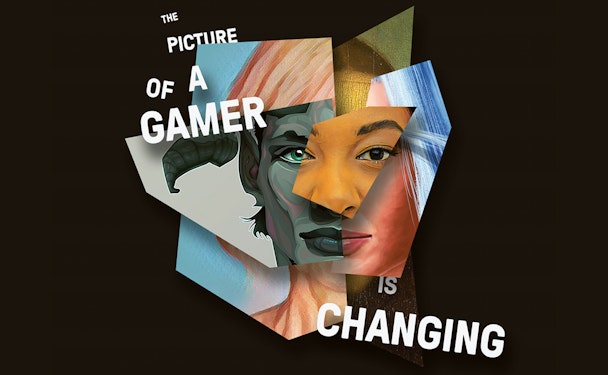Gaming in 2021 will transform how brands interact with consumers forever
One third of the global population now plays video games, from casual mobile apps to internationally live-streamed esports competitions. But “gamers” remain misunderstood: they make up an audience as diverse and complex as the games they play. Brands will need to move beyond stereotypes to connect authentically and unlock the true value of the gaming universe.

Gamers are not who brands think they are
The case for gaming as an advertising platform is clear: Gaming is predicted to reach over 2.8 billion people globally in 2021 (that’s over one in every three individuals across the world playing a game across mobile, console or PC) and gamers are predicted to generate over $189.3 billion in revenue. In the wider context of the entertainment industry, American sports alone is estimated to be a $75bn industry and the global film industry $100bn. Gaming is already bigger than both of these combined and becoming an ever important and developing part of the wider entertainment ecosystem.
One of The Drum’s Predictions for 2021 is that gaming will transform how brands interact with consumers forever, but to do that will require a more sophisticated understanding of the individuals who play games, as outlined by Jonathan Stringfield, VP, global business marketing, measurement & insights, Activision Blizzard Media.
Watch the full Predictions 2021 session above.
One of the biggest roadblocks for marketers in understanding gaming is the audience; beset by fairly standard, outdated stereotypes in terms of who or what comprises a gamer. To help alleviate that, Activision Blizzard Media carried out a research study of 21,000 gamers to segment gaming by demographics and device usage, as well as how players interact and find comfort or fulfillment through gaming. The aim was to equip marketers with a much more sophisticated understanding of gaming audiences.
The study uncovered a clear split and important distinction between those who actually identified as a gamer and those who did not, suggesting that the title of “gamer” may be problematic - both for the people who enjoy gaming entertainment and for marketers in how they conceptualise and categorise this form of entertainment and engage with its players.
“A lot of consumers interacting with the gaming ecosystem do not really consider themselves a gamer and, as marketers, we don’t want to try and lump them in and use this terminology in a way that doesn’t fit with their own conception and behaviours,” explained Stringfield. “Much in the same way that if we were looking for folks who were into films, we wouldn’t just look for a cinefile. That same general rule applies in gaming - some of the labels that we have attached to gaming have already become problematic, meaning that our thinking needs to move on.”
The research uncovered four key insights crucial for marketers to understand: There are at least six distinct gamer personas; Less than half of all gamers identify as a “gamer”; Only a small minority of all gamers fit the typical stereotype of a “gamer”; and The “Exclusive Platform” player is rare.
“If we’re only thinking through the lens of “gamer”, we are already potentially missing out on half the individuals in the gaming ecosystem,” said Stringfield. “The potential for marketers to work with, understand and reach audiences through various touchpoints is much more diversified.”
By segmenting these consumers, Activision Blizzard Media identified six gamer personas: Lifestylists (10.9%), Player Ones (24.8%) and Next Levelers (4%) - all of which fall under the more traditional definition of a gamer. But, in addition: Super swipers (32%), The Dabblers (18.8%) and Denialists (9.9%) - all of which don’t identify as a gamer.
Taking these statistics at face value, that means that more than 50% of people who play games don’t consider themselves to be a gamer. The most emblematic set, as Stringfield outlines, is between the ‘Denialists’ and Llifestylists’ - both legitimate, hefty gamers that get a lot of value out of gaming and interact with the ecosystem in multiple ways, yet are distinctly split on the axis of identification.
“It’s quite meaningful in terms of how marketers think about the right way to address and integrate into these experiences, understanding that there are different need states and levels of attachment and/or identity attached to gaming as an entertainment form,” said Stringfield.
Looking ahead to 2021, there are three key opportunities for marketers:
- Know your audience - gamers are multi-faceted and diverse, so brands should think beyond the gamer stereotype, through the same lens and thought process around social, television or movies, to reach a variety of different audience groups.
- Look to mobile - mobile provides scale, multiple means of entry and some of the most flexible mechanisms, which is a great place for marketers to start and really understand the best way to potentially integrate more within the overall ecosystem of gaming.
- Context matters - gaming provides the opportunity for creative experimentation but creating the right experience on the right platform, which is inherently brand safe, is the key to success.
“Some of the best opportunities are in high quality games and, by merit, an opportunity for brands to get integrated in a highly scaled, immersive entertainment platform,” said Stringfield.
For a deeper dive on what this new gaming audience looks like, watch the full ‘Gamers are not who brands think they are’ session above.
Content created with:

Activision Blizzard
Activision Blizzard Media is the media and advertising arm of Activision Blizzard – one of the most iconic interactive entertainment companies in the world. Our...
Find out more